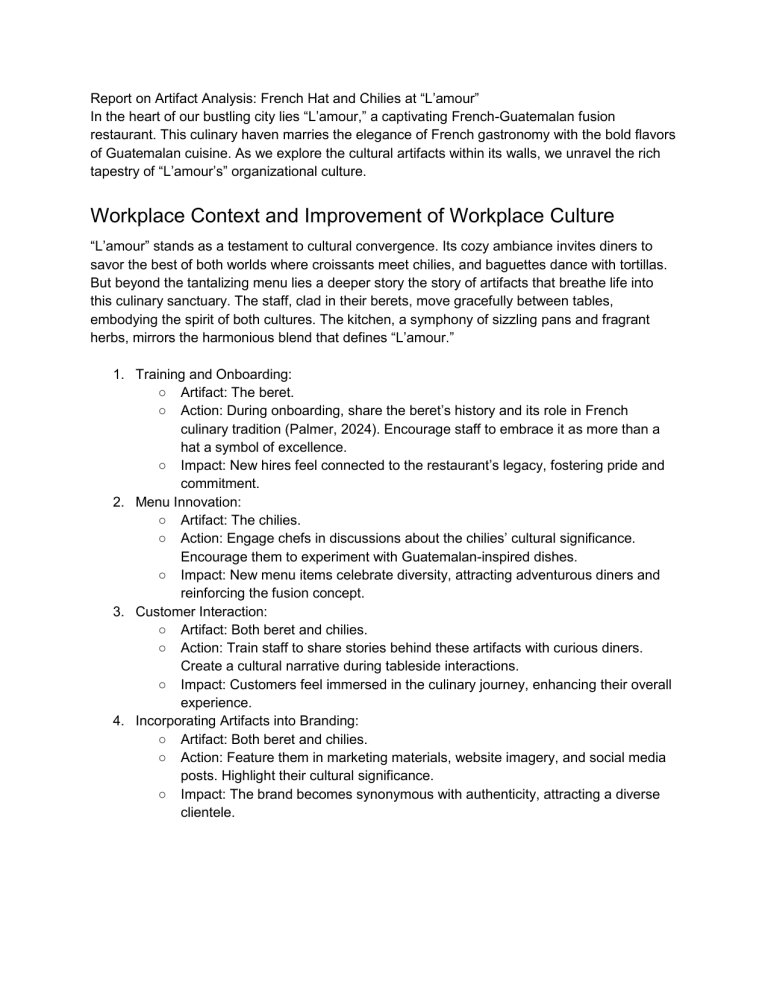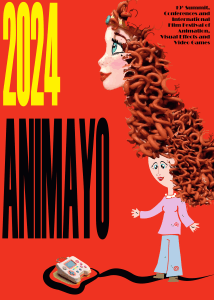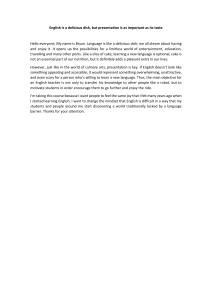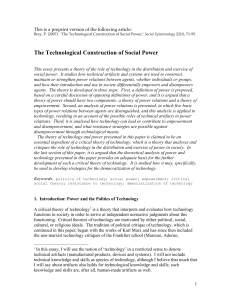
Report on Artifact Analysis: French Hat and Chilies at “L’amour” In the heart of our bustling city lies “L’amour,” a captivating French-Guatemalan fusion restaurant. This culinary haven marries the elegance of French gastronomy with the bold flavors of Guatemalan cuisine. As we explore the cultural artifacts within its walls, we unravel the rich tapestry of “L’amour’s” organizational culture. Workplace Context and Improvement of Workplace Culture “L’amour” stands as a testament to cultural convergence. Its cozy ambiance invites diners to savor the best of both worlds where croissants meet chilies, and baguettes dance with tortillas. But beyond the tantalizing menu lies a deeper story the story of artifacts that breathe life into this culinary sanctuary. The staff, clad in their berets, move gracefully between tables, embodying the spirit of both cultures. The kitchen, a symphony of sizzling pans and fragrant herbs, mirrors the harmonious blend that defines “L’amour.” 1. Training and Onboarding: ○ Artifact: The beret. ○ Action: During onboarding, share the beret’s history and its role in French culinary tradition (Palmer, 2024). Encourage staff to embrace it as more than a hat a symbol of excellence. ○ Impact: New hires feel connected to the restaurant’s legacy, fostering pride and commitment. 2. Menu Innovation: ○ Artifact: The chilies. ○ Action: Engage chefs in discussions about the chilies’ cultural significance. Encourage them to experiment with Guatemalan-inspired dishes. ○ Impact: New menu items celebrate diversity, attracting adventurous diners and reinforcing the fusion concept. 3. Customer Interaction: ○ Artifact: Both beret and chilies. ○ Action: Train staff to share stories behind these artifacts with curious diners. Create a cultural narrative during tableside interactions. ○ Impact: Customers feel immersed in the culinary journey, enhancing their overall experience. 4. Incorporating Artifacts into Branding: ○ Artifact: Both beret and chilies. ○ Action: Feature them in marketing materials, website imagery, and social media posts. Highlight their cultural significance. ○ Impact: The brand becomes synonymous with authenticity, attracting a diverse clientele. The Significance of Artifacts Artifacts carry the essence of tradition. By examining them, we honor the past and preserve cultural identity. Artifacts reflect shared values and beliefs (Foster, 2024). They serve as silent messengers, whispering stories of what matters most to an organization. Artifacts are more than mere objects; they are vessels of meaning. They carry the whispers of tradition, the echoes of history, and the aspirations of a collective. In the context of workplace culture, artifacts serve as tangible bridges between past and present (Causey, 2017). They ground employees, reminding them of their purpose and identity. Artifacts shape the ambiance and aesthetics of a workplace. They influence how customers perceive the brand. The chilies, displayed prominently, evoke curiosity and anticipation. Diners associate them with authenticity and adventurous flavors. Analyzing this impact helps “L’amour” fine-tune its dining experience. For example.The Red Cross’s Symbol Artifact: The iconic Red Cross symbol. The Red Cross emblem is a powerful cultural artifact (Causey, 2017). It represents humanitarian aid, neutrality, and compassion. Volunteers and staff wear it proudly, embodying the organization’s mission. The symbol transcends language barriers and unites people globally in times of crisis. Also, Retail Industry: Employee Handbook Artifact: Employee Handbook. Impact: Nordstrom’s legendary employee handbook is a cultural artifact. It famously states, “Use your best judgment in all situations.”(Causey, 2017). This simple phrase empowers employees, emphasizing trust, autonomy, and customer-centric decision-making. Also, Manufacturing Industry: Toyota Production System Artifact: Toyota Production System (TPS). Impact: TPS is a set of principles and practices that guide Toyota’s manufacturing processes (Palmer, 2024). It emphasizes continuous improvement, waste reduction, and respect for people. TPS artifacts include visual management boards, standardized work instructions, and the Andon cord. a. The French Hat (Beret) ● Crafted by a local artisan, the beret embodies timeless elegance. Its soft wool cradles memories of Parisian streets and bustling bistros (Palmer, 2024). The hands that shaped it carried the legacy of generations—seamstresses who stitched dreams into fabric. ● Usage: Staff members wear the beret as part of their uniform—a nod to professionalism and pride. When a waiter adjusts the beret, it’s not just about aesthetics; it’s a ritual—an acknowledgment of their role as culinary ambassadors. ● Purpose: The beret whispers sophistication, evoking images of chefs perfecting their sauces and sommeliers selecting the finest wines. It symbolizes attention to detail, a commitment to culinary finesse. When a chef dons the beret, they step into a lineage of culinary mastery. ● Success: The creator(s) succeeded admirably the beret seamlessly integrates with “L’amour’s” fusion concept. It perches atop heads, a silent promise of culinary magic. The beret doesn’t merely shield from kitchen heat; it shields the spirit of “L’amour.” b. The Vibrant Chilies ● Creator: These chilies arrive from local Guatemalan markets (Foster, 2024). their journey from farm to table a testament to freshness. ● ● ● Usage: In the bustling kitchen, the chilies add a splash of color. Diners catch glimpses of them as they sizzle in pans, releasing their fiery essence. The chef’s hands cradle them, slicing with precision, infusing dishes with warmth. Purpose: Chilies embody more than heat; they carry the soul of Guatemalan cuisine. Their vibrant hues hint at bold flavors, passion, and warmth—the very essence of “L’amour.” Success: The chilies triumph in their purpose. They infuse dishes with zesty kicks, leaving taste buds tingling and hearts warmed. Interaction with Artifacts ● ● Staff: As staff don their berets, they step into roles as culinary ambassadors. The hat becomes a badge of honor, connecting them to a rich tradition of French gastronomy. Customers: Diners admire the chilies—some with curiosity, others with anticipation. The chilies’ vibrant hues hint at the explosion of flavors awaiting them. They become conversation starters, sparking discussions about spice levels and regional cuisines. Reflection of Organizational Culture ● ● ● ● ● Culinary Excellence: ○ Artifact: The beret. ○ Culture Statement: “At ‘L’amour,’ we strive for culinary excellence in every dish.” ○ Comparison: The beret, worn by staff members, symbolizes attention to detail, precision, and a commitment to mastering the art of French cuisine. It aligns with the belief that every plate leaving the kitchen should be a masterpiece. Heritage and Tradition: ○ Artifact: The beret’s history. ○ Culture Statement: “We honor the rich heritage of French culinary traditions.” ○ Comparison: By preserving the tradition of wearing berets, “L’amour” communicates respect for the past. The beret becomes a tangible link to generations of chefs who perfected their craft. Professionalism and Pride: ○ Artifact: Staff members wearing the beret. ○ Culture Statement: “Our team takes pride in their work.” ○ Comparison: The beret isn’t just an accessory; it’s a badge of honor. Employees wear it with pride, embodying professionalism and a sense of purpose. Norms and Beliefs: ○ The beret reflects “L’amour’s” commitment to excellence. It whispers, “We take our craft seriously; every dish is a masterpiece.” ○ The chilies mirror the boldness and authenticity of Guatemalan culture. They say, “We celebrate flavors that dance on the edge.” Comparison with Workplace Culture Statements: ○ ○ ○ Mission Statement: “L’amour” aims to create a harmonious blend of French and Guatemalan culinary traditions. The artifacts embody this fusion. Slogan: “Where Flavors Collide” resonates with the chilies’ fiery spirit. Vision Document: The artifacts align with the vision of a culturally rich dining experience—one that transcends borders and tantalizes taste buds. Conclusion The French hat and chilies are more than decorative pieces; they are conduits of culture. They invite diners to embark on a sensory journey, where flavors intertwine, and stories unfold. “L’amour” wears its heart on its sleeve or rather, on its beret and chilies and invites us all to savor life’s delectable moments. Sources Natalie, F. (2024). How Can Cultural Artifacts Shape An Organization’s Environment? How Can Cultural Artifacts Shape an Organization's Environment? - GREY Journal Brad, P. (2024). How to use artifacts to make workplace celebrations stick How to use artifacts to make workplace celebrations stick (jostle.me) Charles, C. (2017). Company Culture as Artifacts Company Culture as Artifacts. A Useful Definition of Company Culture | by Charles Causey | Medium






